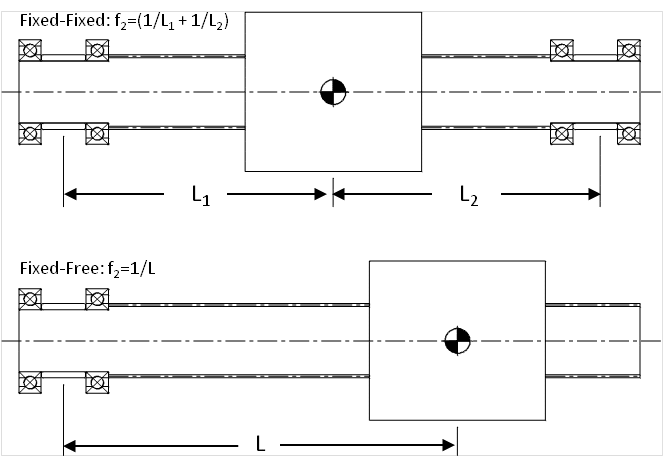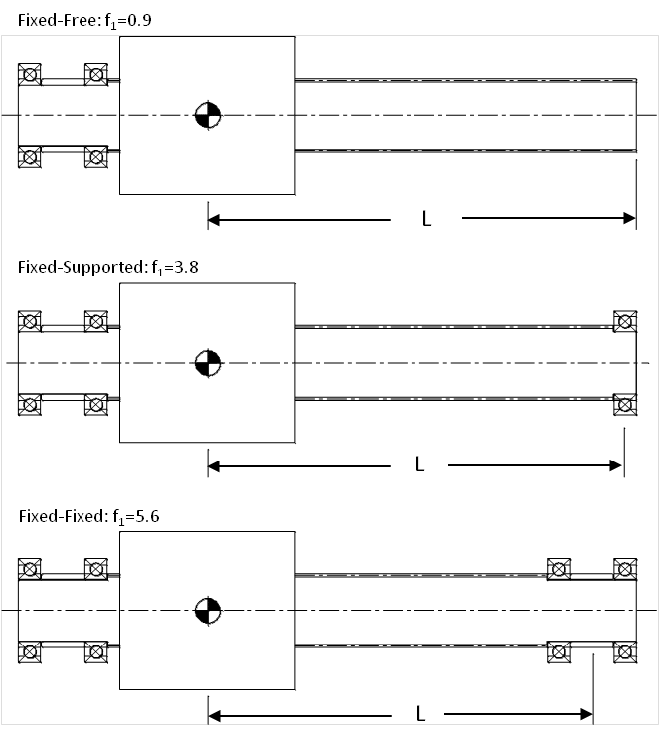Planetary Roller Screw Differences – Selection Process
The data on the following pages is designed to assist you in selecting the proper screw size for your application. Please contact our Sales Engineering department for assistance, if required.
Basic Dynamic Load Ratings (C):
Dynamic load is used to calculate the fatigue life of a planetary roller screw. The dynamic load rating is defined as load, constant in magnitude and direction under which 90% of a statistically significant number of apparently identical planetary roller screws reach an operating life of ![]() revolutions (L10).
revolutions (L10).
Static Load Ratings (C0):
Static Load rating (C0) is a load that causes permanent deformation at the most heavily loaded contact equal to .0001 of the curvature diameter of the rolling element.
Static Load Safety Factors (S0):
In order to prevent deformations that could impair the proper function and the operating noise of the planetary roller screw, a safety factor (S0) should be used when selecting a roller screw based on basis of its static load rating. For operations with quasi-static load applications (such as presses) where load occurs primarily on the same portion of the stroke, it is recommended to use a higher S0.
Theoretical Life:
Theoretical life (L10 or Lh) is the operating time reached by 90% of a group of apparently identical planetary roller screws operating under the same conditions. Theoretical life is calculated as:
![]()
Where:
![]() = Life(millions of shaft revolutions)
= Life(millions of shaft revolutions)
![]() = Dynamic load capacity (kN)
= Dynamic load capacity (kN)
![]() = Cubic mean load (kN)
= Cubic mean load (kN)
![]() = Required dynamic load capcity (kN)
= Required dynamic load capcity (kN)
Theoretical life, normally expressed in 106 revolutions, can be expressed in different operating units such as hours:
![]()
Where:
![]() = Life(hrs)
= Life(hrs)
![]() = Screw equivalent rotational speed(rpm)
= Screw equivalent rotational speed(rpm)
Equivalent Load:
Operating Loads can be quantified by the incremental load and stroke characteristics that the system is subject to: masses, inertia, etc. For systems with varying conditions (changes of load magnitude, duration, and/or speed), a more complex calculation would be required. Please contact CMC sales engineering for more information on these types of applications. The equivalent load is the calculated cubic mean operating load used for determining life. This is dependent on load pattern.
Equivalent cubic mean load can be calculated as:
![Rendered by QuickLaTeX.com \[ F_m=\frac{ (F_1^3 L_1 + F_2^3 L_2 + F_3^3 L_3 + ...)^\frac{1}{3} }{(L_1 + L_2 + L_3 +...)^\frac{1}{3}} \]](https://www.creativemotioncontrol.com/wp-content/ql-cache/quicklatex.com-32e741e468d0fe9dad7dc22d94e955ad_l3.png)
Where:
![]() = Incremental force components of
= Incremental force components of
stroke(kN)
![]() = Incremental stroke components associated
= Incremental stroke components associated
with each load(mm)
Rigidity of Roller Screw:
The rigidity of a roller screw assembly is a function of many parameters, including: nut rigidity, bearing support rigidity, screw shaft rigidity, mounting housing rigidity, and mounting arrangement. If known, all these parameters can be assembled in a formula as follows:
![]()
Where (rigidity in ….. )
![]() = Total system rigidity
= Total system rigidity
![]() = Screw shaft rigidity
= Screw shaft rigidity
![]() = Nut rigidity
= Nut rigidity
![]() = Housing rigidity
= Housing rigidity
Rigidity Fe Factor

The screw rigidity can be calculated as:
![]()
![]() = Rigidity of the screw
= Rigidity of the screw
![]() = Screw pitch diameter (mm)
= Screw pitch diameter (mm)
![]() = Shaft stiffness factor
= Shaft stiffness factor
The nut rigidity can be calculated as follows:
![]()
![]() = Applied load (N)
= Applied load (N)
![]() = Nut stiffness factor (provided on request)
= Nut stiffness factor (provided on request)
Column Strength:
If the screw is subjected to compressive loads, a verification of its suitability to the loading conditions must be evaluated. The buckling capacity of the screw can be evaluat-ed as follows:
![]()
Where:
![]() = Buckling strength (N)
= Buckling strength (N)
![]() = Shaft stiffness factor dependent on end condition (see table)
= Shaft stiffness factor dependent on end condition (see table)
![]() = Screw shaft root diameter (mm)
= Screw shaft root diameter (mm)
![]() = Free length (distance between support bearings)
= Free length (distance between support bearings)

Critical Speed:
- The maximum achievable rotational velocity of a CMC roller screw is affected by these parameters:
Diameter and free length of the screw - End support configuration
- Rotational Speed capability
- Rotating component (nut or screw)
The critical speed of the screw shaft is calculated as follows:
![]()
Where:
![]() = Critical speed of screw shaft ( n o safety factor) (rpm)
= Critical speed of screw shaft ( n o safety factor) (rpm)
![]() = End support stiffness factor
= End support stiffness factor
![]() = Screw outside diameter (mm)
= Screw outside diameter (mm)

Efficiency and Driving Torque:
The efficiency of a planetary roller screw is dependent on its operating parameters. The friction of the system is ependent on many factors that can vary. The following calculation is a simplification of the screw selection process that can change based on variables.
![]()
![]()
![]()
Where:
![]() = Theoretical direct efficiency: converting shaft rotation into axial motion
= Theoretical direct efficiency: converting shaft rotation into axial motion
![]() = Theoretical indirect efficiency (backdriving)
= Theoretical indirect efficiency (backdriving)
![]() = Practical efficiency: the value of 0.9 should be used as an average value between the practical efficiency of a new screw and that of a normally run screw.
= Practical efficiency: the value of 0.9 should be used as an average value between the practical efficiency of a new screw and that of a normally run screw.
This is the value that should be used for all industry applications in all normal working conditions.
![]() = Lead of screw (mm)
= Lead of screw (mm)
![]() = Pitch diameter of screw (mm)
= Pitch diameter of screw (mm)
![]() = Coefficient of friction
= Coefficient of friction
Torque Required:
To move an axial load at constant speed the screw requires a motor torque and its magnitude can be calculated as:
![]()
Where:
![]() = Required input torque ( Nm)
= Required input torque ( Nm)
![]() = Axial load developed by screw ( N)
= Axial load developed by screw ( N)
To restrain an axial load, the screw must be equipped with a brake. The restraining torque is calculated as:
![]()
Where:
![]() = Required braking torque ( Nm)
= Required braking torque ( Nm)
NOTE: Start-up torque will be greater than the value ![]() .
.

